What is Programmatic SEO?
Programmatic SEO (pSEO) is the method of mass-producing pages of content using a database to rank high in Google’s search results for similarly-structured, long-tail keywords.
Rather than manually writing a long-form piece of content for every topic in a cluster, you can use programmatic SEO to automate the content writing and publishing processes for hundreds or thousands of web pages.
While it is not applicable to every niche and content type, there are still plenty of ways to implement this SEO strategy into your website. Here, we'll take a deep dive into programmatic SEO and provide some examples to help give you some inspiration for your own project.
Examples of Programmatic SEO
- Tripadvisor: They use programmatic SEO to generate thousands of localized travel guides, each optimized for specific keywords.
- Airbnb: Their city-specific landing pages are a classic example. Each page targets different search intents related to accommodations in various cities.
- Yelp: They create pages for every business listed on their site, optimizing each for local search queries.
When is it Best to Use Programmatic SEO?
Programmatic SEO is the most useful if your content meets the following criteria:
- The content has one encompassing theme and shares the same head term.
- The content theme has a substantial search volume.
- Most of the long-tail keywords have a relatively low keyword difficulty.
- The end goal is to publish hundreds or thousands of pages.
- You plan on utilizing a headless content management system (CMS).
- Sourcing the information (data) for each landing page will be somewhat low-effort.
Advantages of Programmatic SEO

ahrefs-site-explorer-overview-zapier-apps
There are many advantages to adopting a programmatic SEO strategy:
SEO benefits
First and foremost, the goal of programmatic SEO is to attract as much organic search traffic as possible.
A successful programmatic SEO campaign can significantly boost your website’s search engine visibility, domain authority, link building opportunities. This is achieved by creating a superb user experience (UX), as well as authoritative and quality content that solves the user’s search intent.
Speed to market
Creating pages programmatically is the fastest way to deploy a website project. In just seconds, you can create landing pages by leveraging data automation. Because of its exponential speed, programmatic SEO is optimal for any SaaS go-to-market strategy.
Also regarding speed, programmatic SEO reduces the reliance on engineers and allows marketers to make fast and frequent iterations to all the landing pages.
Scalability
One of the most common ways that marketers come across programmatic SEO is they have an idea for creating a large-scale content marketing strategy but are concerned with the amount of effort it will take to deliver. Content that is automatically generated dramatically increases the practicality of executing a website project at scale. Additionally, data can continuously be added down the road to keep expanding the content theme.
Consistency in design
In addition to the queries being similar, the content of each page is formatted the same using a headless CMS. This way, the content and design elements of the templated page are decoupled and allow for the page layout to easily be replicated with variations of content. Programmatic SEO enables a structured and reusable library of components with flexible variations.
Uniqueness
The underlying benefit of programmatic SEO is that it results in the creation of unconventional content that differentiates you from the competition. The reality is that in today’s content landscape, blogs can only take you so far. Organizations need to create content that provides exceptional, unparalleled value. With a bit of ideation, there are endless applications for implementing programmatically generated pages.
How to Do Programmatic SEO
Let’s dive into the actual process of implementing a programmatic SEO project.
1. Choosing a head term
The head term is the core of your content's theme.
For example, Tripadvisor consistently ranks at the top of Google’s search results for the head search term “things to do in [city name]”. In this case, "things to do in" is the head term used for every programmatic page.
Other examples of head terms could be:
- "seating capacity"
- "average snowfall"
- "vegan recipe"
By themselves, head terms may have a large amount of search volume and less relevance to your content. Oftentimes, they do not even signal high intent. Therefore, the real opportunity is unlocked when you begin to add modifiers to the head term.
2. Identifying long tail keywords
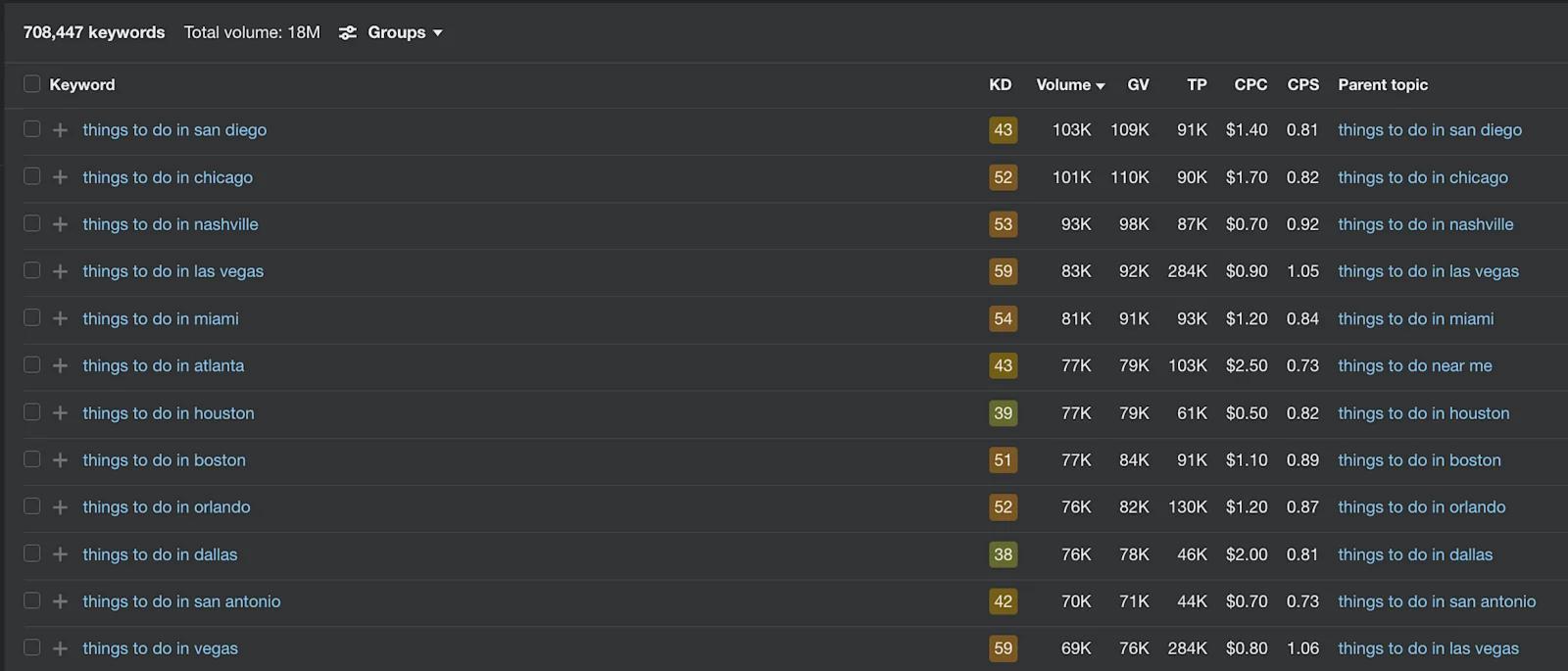
ahrefs-keyword-explorer-things-to-do
Modifiers can be used to create long-tail keywords from your head term. Each landing page should be structured to include your head term, plus one unique modifier.
For example, Tripadvisor uses their head term “things to do in” with modifiers such as “San Diego”, “Nashville”, or “Phoenix” (each city having its own landing page). With this approach, they are able to address tens of thousands of specific search queries.
For our other previous head term examples, you would do:
- "seating capacity + [stadium]"
- "average snowfall + [city]"
- "vegan recipe + [food]"
Individually, each keyword will most likely have a relatively small amount of search volume. However, they will have a significant impact collectively. When programmatic SEO is used across hundreds or even thousands of pages, your reach becomes exponential. Moreover, you gain topical authority with the more similar content you publish. If Google can recognize you as an expert and reliable source on anything related snowfall, all your programmatic pages will benefit.
Discovering these modifiers can best be done with a keyword research tool such as Ahrefs or Google Search Console. This long-tail keyword research gives you insight into metrics most relevant to your user’s behavior, including search volume and keyword difficulty. Equipped with all the data, you can begin to pinpoint which modifiers will be most valuable to your programmatic SEO strategy.
3. Create pages that directly address search intent
Since many of the target keywords will have low competitiveness, writing long-form content will be less necessary. However, you want to avoid creating doorway pages and poor-quality, thin content.
As previously mentioned, the key to programmatic SEO is understanding a user’s intention. Many programmatic SEO strategies will revolve around transactional intent - meaning that users are looking to take a specific action or find a particular solution. Being long-tail keywords, these niche searches are often lower in the funnel and therefore signify a high intent.
Another important factor is an internal linking strategy. Within your landing page template design, you should include a “related”, “top”, or “other” section that leverages the power of internal links. This will in turn boost the performance of all your programmatic pages.
4. Generate pages automatically at scale with data
To begin the process of generating pages, you must first collect data for each page. Sometimes, you may already have a dataset or user generated content. Other times, you may need to research and curate the data manually.
In regards to software tools, there are several leading platforms for generating pages programmatically, including WordPress, Webflow, and Hubspot.
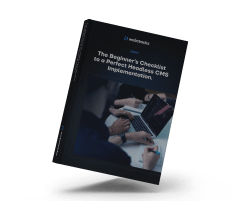
Examples of Programmatic SEO
There are endless ways to put programmatic SEO into action. In our experience, we've had the most success with programmatically generated integration pages. With similarly structured keywords and page templates, we created a near-infinite amount of pages that targeted high-intent keywords, and drove a significant amount of organic traffic.
Here, we will showcase how Webstacks took inspiration from Zapier’s programmatic SEO strategy to help two clients design and develop extensive integration libraries.
Calendly’s Integrations
Webstacks produced a brand new design to better showcase Calendly’s integration library.
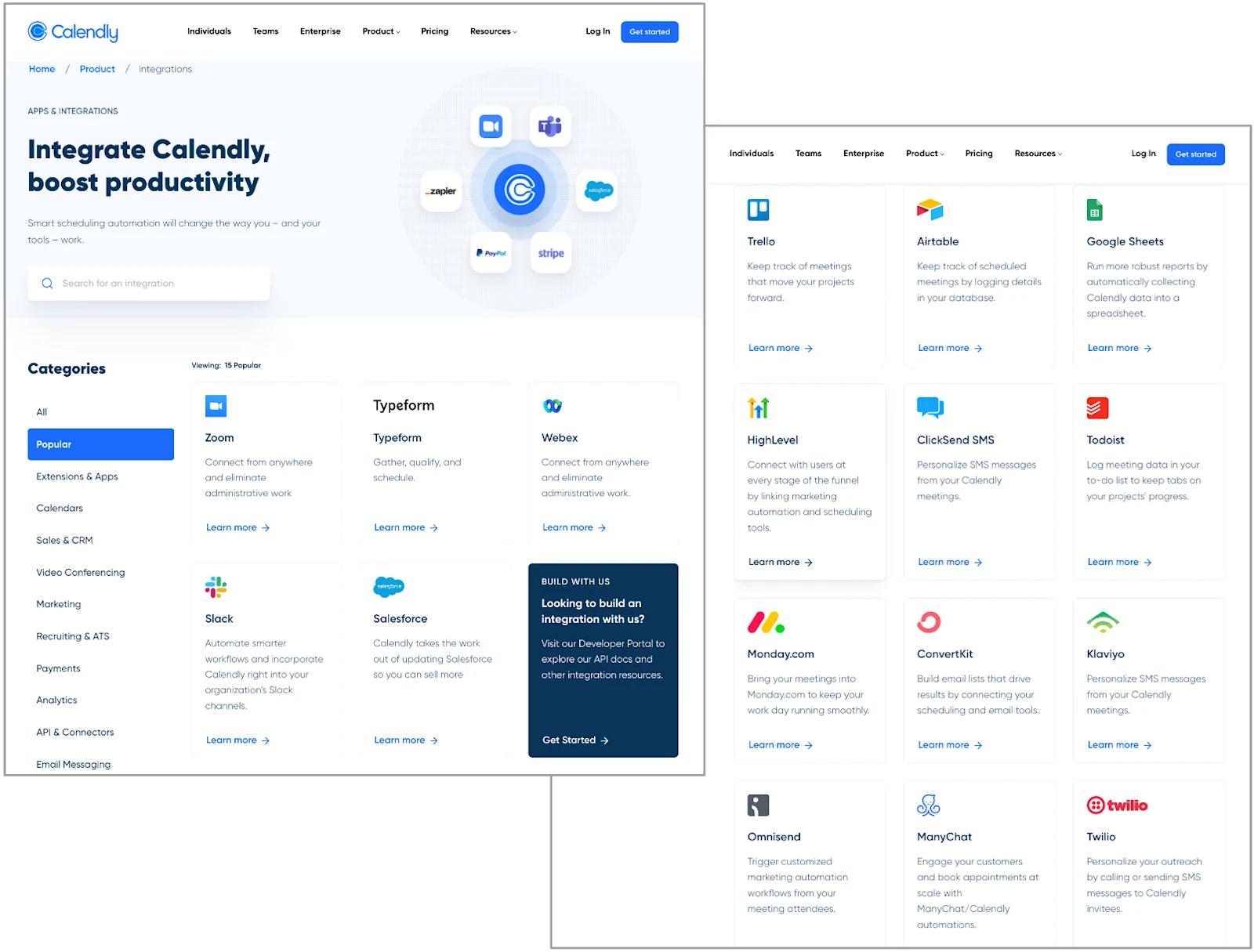
Calendly Integration Library
Programmatically generated pages allowed us to quickly build a single framework, then edit each integration page’s content without altering the design or layout.
Calendly is now optimized to rank for any searches related to “[Calendy][Tool] integration”.
In addition to SERP optimization, we were able to enhance the integrations home page with search functionality and category filtering.
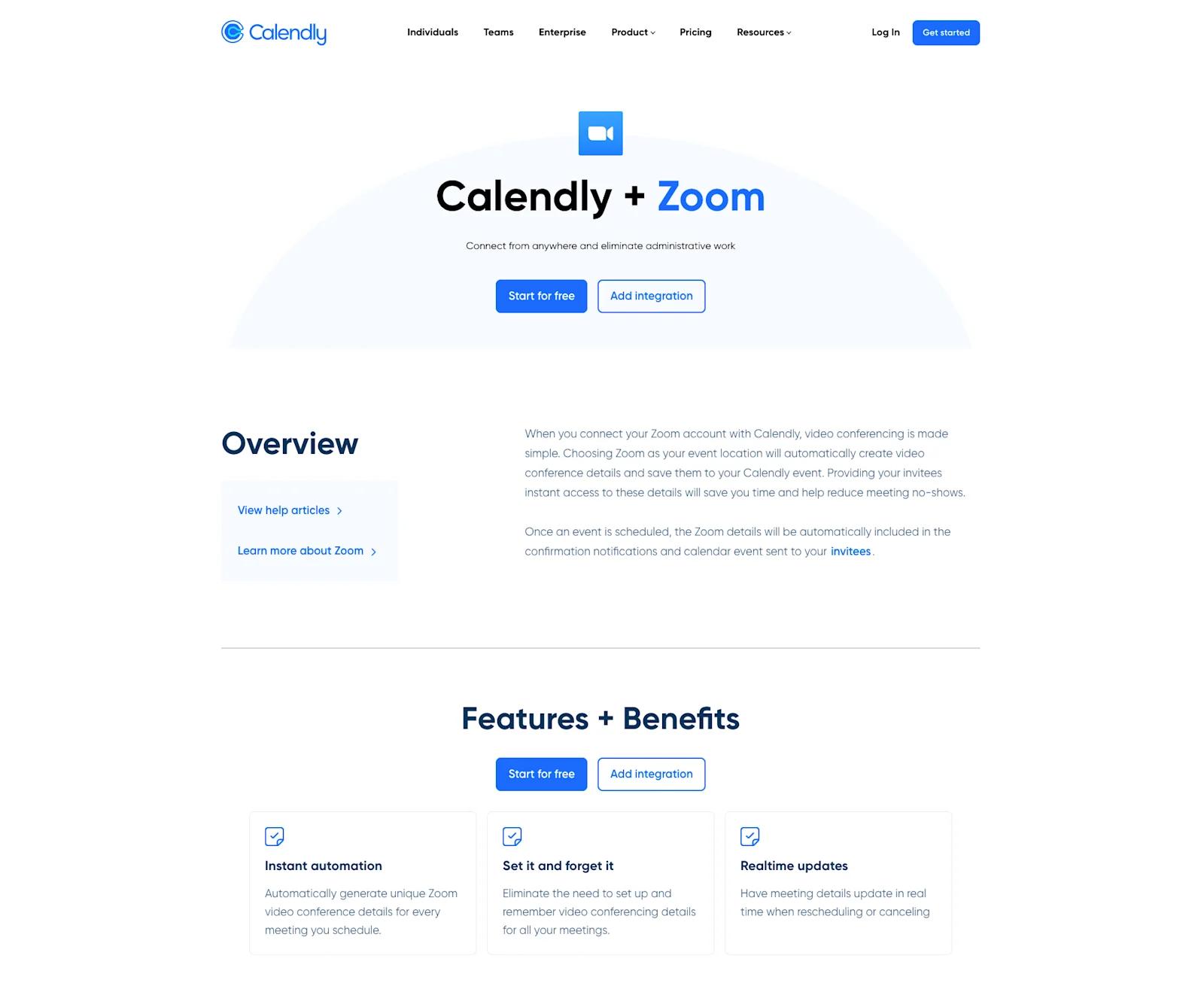
Calendly + Zoom Landing Page
An example from Calendly’s Integrations is this “Calendly + Zoom” page. While the design layout for every individual page is the same, each Zoom-related content section is sourced from the database and automatically inserted.
From a conversion standpoint, each page has multiple apparent CTAs that directly address the user’s search intent (integrating Calendly with Zoom).
Thanks to programmatic SEO, Calendly has been able to achieve a network effect with its integrations. As Calendly adds more partners, its platform becomes more valuable to users. Subsequently, as Calendly attracts more users, more applications will want to join their integration library.
To make the publishing process even more efficient for new integrations, Calendly can request that tools interested in partnering with them fill in the content (data) for their integration page via their Developer Portal. This way, creating a new page requires nearly zero effort from Calendly and is practically built on its own.
From 95 programmatically generated pages, Calendly has seen some incredible results:
- More than 2,600 new backlinks
- Over 4,700 new organic keywords
- And over 4,600 organic traffic per month
Retool Database Integrations
Another example of programmatic SEO is the Zapier-inspired Retool integration library.
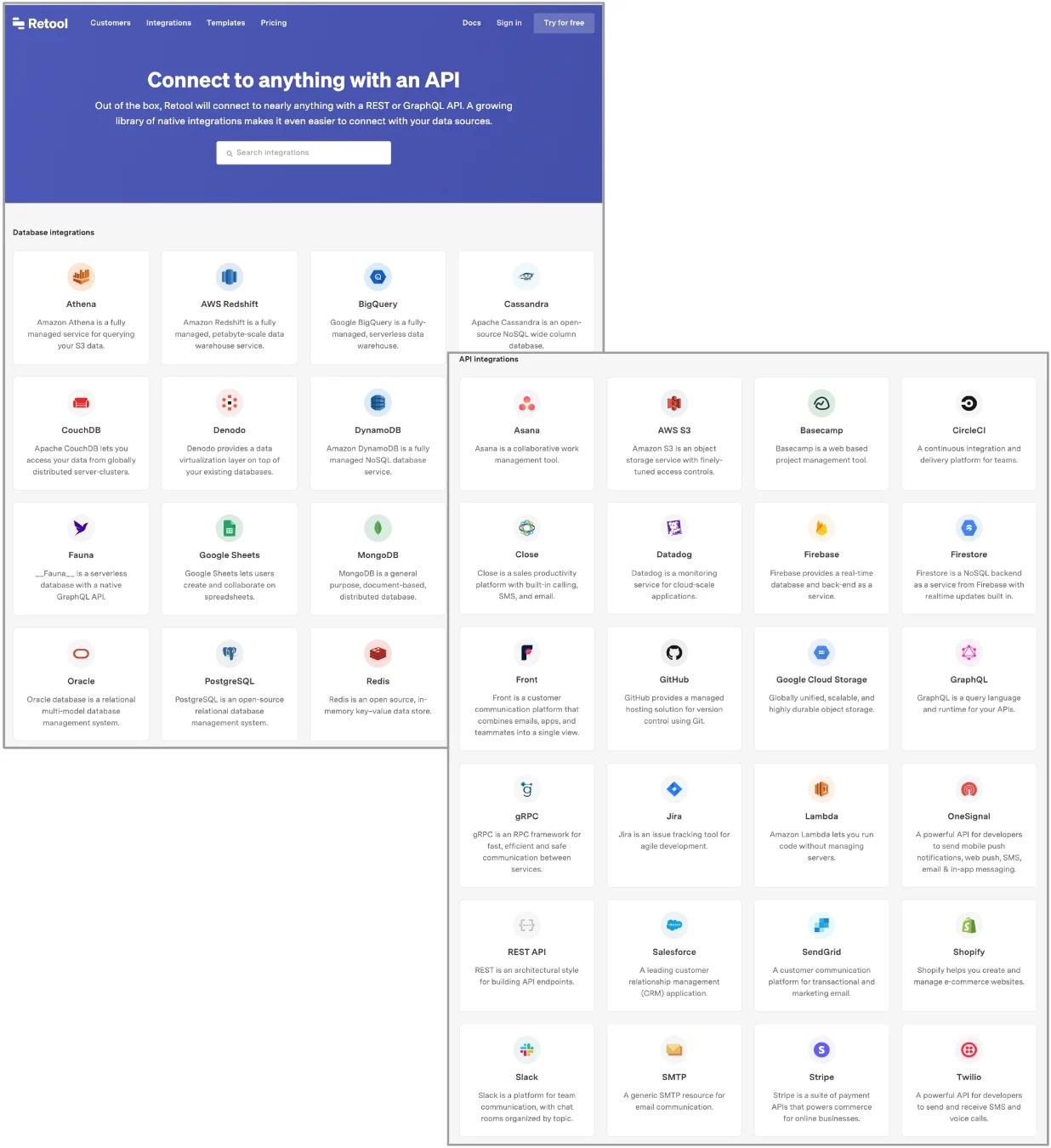
RetoolIntegrationsLibrary
Now, Retool’s integration content is structured to maximize search rankings and conversions for “[retool] [application name] integration” searches.
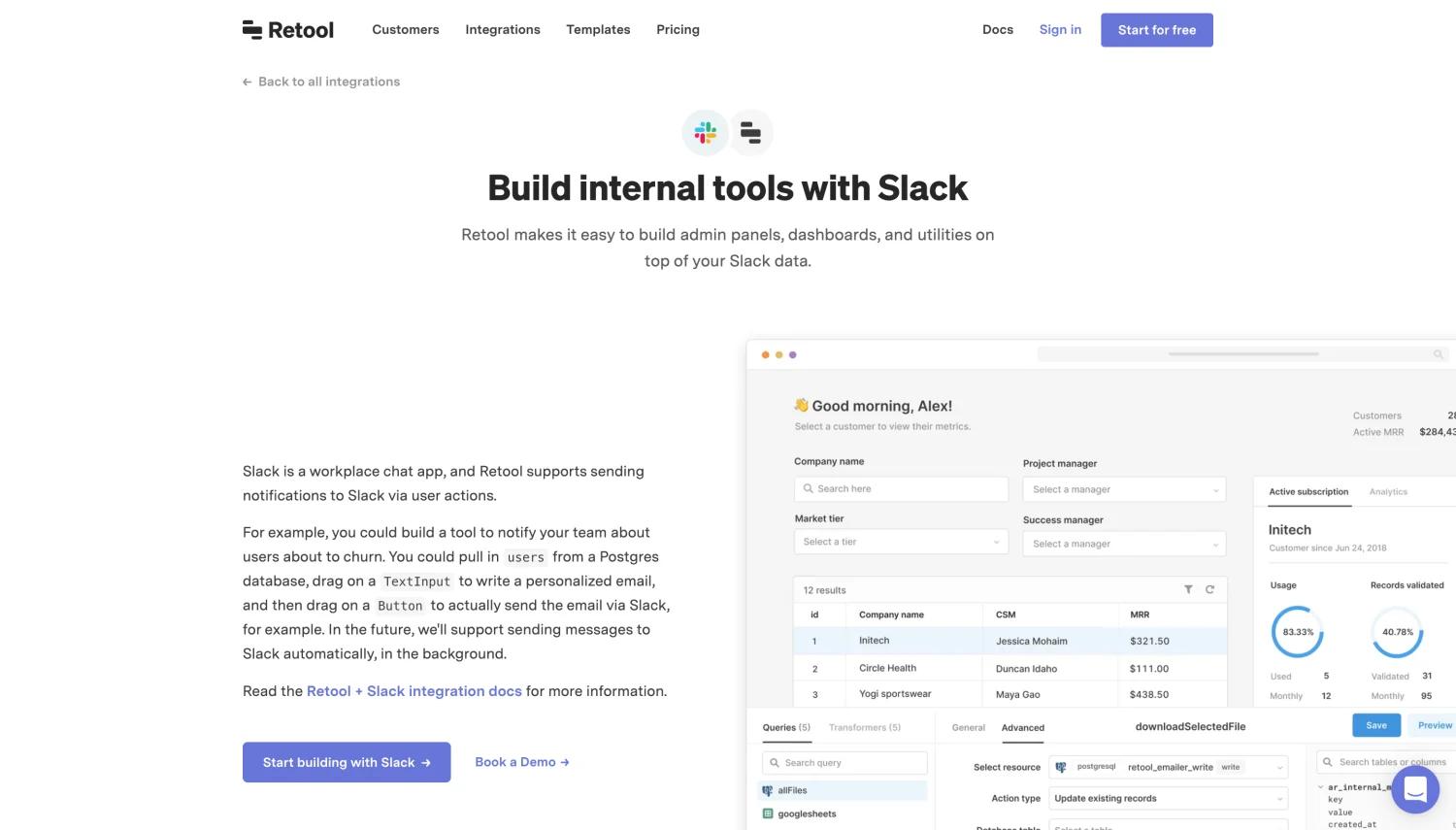
Retool Slack integration
An example of a Retool integration is this Slack page, which is optimized to rank highly for query “[Retool][Slack] integration”.
Just like Calendly, each Retool integration page has the same layout and CTA placement.
From 43 programmatically generated pages, Retool has achieved:
- More than 850 backlinks
- Over 3,200 new organic keywords
- And over 1,900 organic traffic per month
Get Started With Programmatic SEO
Given its limitless possibilities, programmatic SEO can be a tremendous organic growth tool for SaaS companies. Beyond its search engine optimization implications, this strategy also aligns with other top priorities, such as speed to market, efficiency, and scalability.
At Webstacks, programmatic SEO has been an overall SEO strategy for clients. If you are interested in learning more about how your organization can develop a programmatic SEO project, feel free to contact our sales team.





